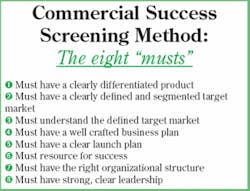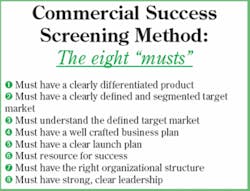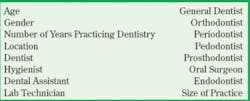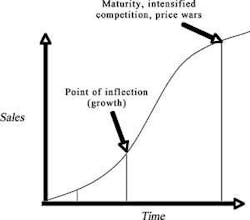How to screen new business opportunities
How many times has a dentist told you he or she has the next great invention? Here’s how to see if it really is the greatest thing since sliced bread.
Story by Jim Poole, MBA Managing Partner, Focused Evolution, Inc. and Chris Gross, MBA Managing Partner, Focused Evolution, Inc.
How many times have you walked into a customer’s practice and they’ve shown you a new product idea or prototype of something they’ve been developing? It’s no surprise that dentists innovate to address their everyday problems. They are the users of your products. They know intimately what works, what doesn’t, and what tweaks to make. Surely you’ve shared in your customer’s excitement when they’ve shown you an idea. But once you’ve seen the product, then what do you do? Wish them luck? How can you really help them? How can you continue to build value into your relationship?
Dentists are highly skilled technicians as well as small business owners, but they typically lack the fundamental business experience and knowledge to launch a new product in the dental market. This article will give you a method to help educate your customers, as well as the ability to screen for the viability of a product’s success.
The eight “musts”
Must have a clearly differentiated product - What are the unique features and benefits of the product? What need(s) is the product solving? Does the product have distinguishable attributes that separate it from the competition? Why would a customer buy this product and what would be the perceived value? Products with incremental improvements (“me too”) command vast resources and typically achieve minimal commercial success.
Most new products are not differentiated and therefore do not make it to market, or quickly find their way to a product graveyard. Often, the entrepreneur builds a product that addresses his or her personal needs and desires without listening to the customer. “If you build it, they will come” is a mentality to which many inventors fall victim. Product development and innovation are not about meeting the need of a single person, but rather the needs of a segmented target. This process is iterative (prototype > test > feedback > new prototype > test > feedback > new prototype, etc.). If the product being evaluated is not clearly differentiated, suggest that the inventor execute market research and prototype testing. Hopefully he/she will receive candid feedback and make the recommended changes.
Must have a clearly defined and segmented target market - Mass marketing to all U.S. dentists is not an effective strategy for a new product. The target market is the specific customer that can be expected to buy the product. The target market can be defined in many ways:
If you ask, “Who will be your customers?” and the response is, “Every dentist in the U.S.,” there is a problem. There are very few products on the market that are needed and desired by every dentist. It is best to target a specific segment, develop the product, launch the product, make changes based upon continuous dialogue and feedback from the market, and then tailor the product to target other markets for expansion.
Must understand the defined target market - It is imperative to know the target market intimately so the message, sales channels, and branding are all managed efficiently and effectively. Several questions should be answered:
- What is the buying behavior of the target market?
- Where do they learn about new products?
- How do they make a decision to try a new product?
- Who influences their decision to try a new product?
- Once they have decided to try a new product, what experience must they have to accept the product and perceive value from the experience?
- How do they decide to use a new product again and adopt it into their practice?
- How many customers have the problem this product intends to solve?
Many companies mistakenly think they know the behaviors of their target market because they know how they behave personally, and they have their experience corroborated by a couple of colleagues. Executing market research (surveys, interviews, focus groups, etc.) requires time, effort, and know-how, but having the discipline to do the front-end work ultimately mitigates risk and leads to greater market success. It is always about the customer! The more intimate a company is with its customers, the better it can serve them. This results in greater commercial success for both parties.
Must have a well crafted business plan - “By failing to prepare, you are preparing to fail.” Benjamin Franklin. A strong business plan critically analyzes the market opportunity and allows businesses to stay focused on the primary objectives. This tool serves as a realistic road map to success and minimizes the risk of impulsive changes in direction. A delicious, well-made meal is usually crafted from a recipe; a business plan is the recipe for a product launch and can be spiced up as needed, but should possess the following ingredients:
- Executive Summary
- Objectives
- Vision/Mission
- Company Summary
- Product(s)
- Market Analysis Summary
- Strategy and Implementation Summary
- Financial Plan - Pro Forma
Must have a clear launch plan - The dental industry is a unique space where products reach maturity within six to nine months of launch. The typical product lifecycle outside of dentistry can take six to nine months of awareness before making any headway (see Fig. 1). This is a launch industry - dental professionals and sales people have been conditioned to pay attention to new products. Therefore it is best to enter the market with a bang to create a greater growth curve before reaching the maturity plateau. Remember, you only get one launch!
There are numerous influences to the buying decisions of dentists (continuing education, manufacturer sales representatives, distribution sale representatives, dental labs, to name a few). How do you break through all of the noise? How do you stand apart and which channels are best for the product? What will be the focus (CE, distribution, direct sales, dental labs, key opinion leaders, etc.) and how will it be resourced?
The first objective of any product launch is to create awareness of the product - which channels will reach the target market most effectively and yield the best ROI? Will the launch be coordinated with a major dental show? What media outlets will be utilized to create awareness and drive demand? The most efficient and cost effective way to launch a product is not to blanket the entire United States, but to choose a strategic geographic region to penetrate using all of your resources.
Must resource for success - Launching a new product takes people and money. Financially, a company can expect to spend approximately $500,000 to launch a product (branding, marketing materials, marketing/strategy consultants, sales training materials, sales incentives, promotions, demo materials, etc.).
To roll out a successful product launch, a skilled team is required to create and execute the tactical plan. The business plan needs to be actionable and managed, not just at a high level but actual day-to-day deliverables. A new company can mitigate the costs and risks associated with building a team of full-time employees by hiring a marketing consulting firm. However, an organization of dedicated full-time people will eventually need to be developed.
The standard protocol for optimum resourcing is to create a business prospectus, secure financial investment, and allocate the funds strategically to maximize impact. Not providing enough resources for the venture often results in staff burnout, deflated morale, and cancelled launch initiatives. It is critical for all involved in product launches to maintain confidence in the strategy, product, people, partners, and customers!
Must have the right organizational structure - Success is predicated upon the ability to build an organization that is committed and capable. A company could have the absolute best strategy on paper and PowerPoint, but if the right people aren’t involved to execute the plan, the venture will fail. Success begins and ends with people - having the right people in the right jobs performing the right tasks. Small businesses often fall into the trap of nepotism or friends helping friends. While this may be convenient, it jeopardizes the entire venture and rarely yields the highest quality results. There is no time to “learn on the job” when a business is preparing to launch a product.
It is imperative that each person has clearly delineated responsibilities and accountability. As a product launch progresses, it will command dynamic changes with little time to waste and even less opportunity for failure. Communication is critical for organizational success; assume nothing, communicate everything, and learn from the collective wisdom and experience of the team as well as the most important voice of all, the customer!
Must have strong, clear leadership - Leadership is an intangible element that can define a company’s success or failure. The organization must operate efficiently and confidently knowing that the leadership clearly understands the path to success. Good leadership doesn’t mean day-to-day micromanagement or hands-off degree of separation. Good leadership consists of:
- Effective communication - candor, clarity, compassion, connected, concise
- Goal setting - what are we striving for and what does success look like?
- Ability to empower team members to achieve their best and meet the team’s goals
- Provide and listen to feedback
- Manage expectations
- Promote consistent accountability
- Ability to motivate the team - lead by example
- Create metrics to measure against the goals
- A full time commitment to the success of the endeavor - not treated as a hobby
As we have learned, and we’re sure you have experienced, launching a new product or business involves numerous variables and challenges. Commercial success happens everyday for products in the right place at the right time. Luck (a combination of preparedness and opportunity) plays a role in product adoption and success, but disciplined application of the principles outlined will effectively manage risks and significantly increase your likelihood of commercial success.
You are viewed by your customers as having expertise in the business side of dentistry. Your entrepreneurial customers will call upon you to evaluate their products and they will seek council from you. In this competitive market where relationships are critical to success and longevity, the more you can help them, the more they can help you. We hope this screening method will give you confidence to speak candidly with your customers when they approach you with the next “great, cool product idea.” We are here to help you succeed, so feel free to contact us with any questions. Good luck, and hopefully some of these products will make it to market.
Focused Evolution, Inc. is a marketing strategy/management consulting firm focused on the dental industry. They specialize in growth strategies including launch planning and execution of start-ups, products, and services. Put the power of organic marketing to work for you. You can reach the authors at [email protected] (top photo) or [email protected] (bottom photo).


